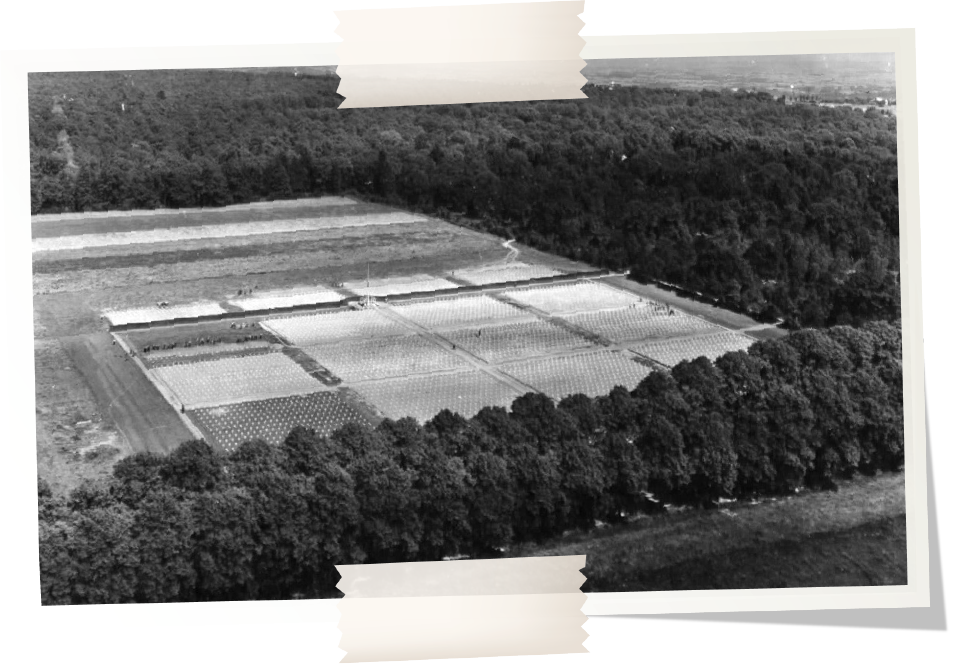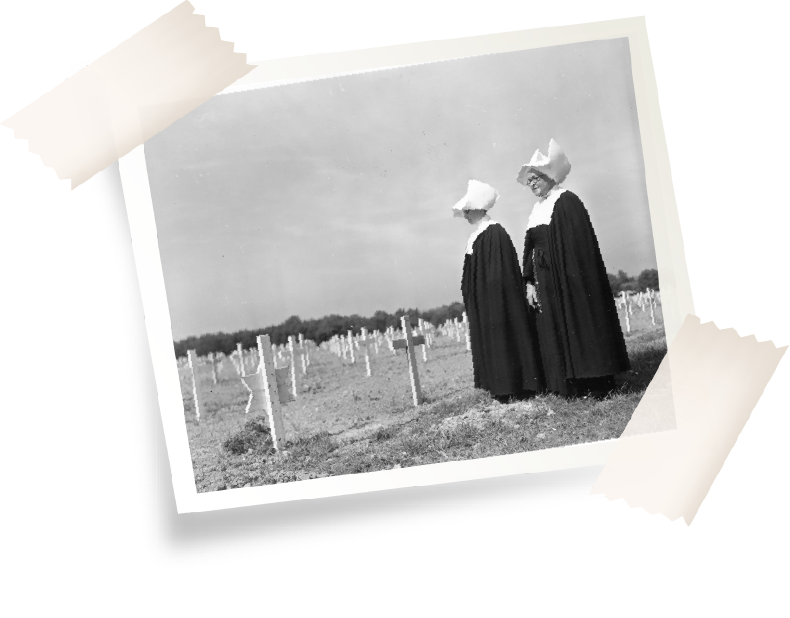Fields of Honor
The only WWII American Cemetery in the Netherlands is situated in Margraten. Belgium has two WWII cemeteries in Henri Chapelle & Ardennes.

American War Cemetery and Memorial Margraten
In 1944, Captain Shomon, commander of the 611th Graves RegistraƟon Company, was assigned to find a locaƟon for a cemetery for the Ninth American Army. At the beginning of October 1944, he reported to the town hall of Margraten and was given access to 30 hectares of land along the highway. The actual construcƟon started in November. Wet weather made construcƟon difficult and moving equipment sank into the muddy surface. Once they arrived in Margraten, the remains were unloaded and stripped of ammuniƟon and personal belongings on the stripping line and buried by men of the Quartermaster Service Company, consisƟng of black soldiers.
On November 10, the first soldier was buried aŌer him, more 20,000 others followed. They were buried every day with a small ceremony, with an American army chaplain always present, who blessed the graves and said a prayer. In addiƟon, each working day ended in the evening with a military ceremony in which the flag was lowered while a bugler blew the 'Last Post' and a guard of honor fired gun salutes. Over 3,000 Germans that had been buried in a field adjacent to the American one were reburied at Ysselsteyn German war cemetery. Russian soldiers were moved to Amersfoort. AddiƟonally, a thousand Commonwealth soldiers, mainly BriƟsh and Canadian, were also moved to cemeteries elsewhere post war.
The Henri-Chapelle American Cemetery and Memorial
The Henri-Chapelle American Cemetery and Memorial is located in Belgium and nowadays covers 57 acres of land. The region of Henri-Chapelle, Belgium, was liberated on September 11, 1944 by troops the 1st US Army under General Courtney Hicks Hodges. Two weeks later, on September 25, 1944, Captain Channing B. Rennie, Jr ‘s 603rd QM Grave RegistraƟon Company established a temporary cemetery. This coincides with the first casualƟes sustained by the VII US Corps in fighƟng in the Hurtgen forest. Later on, soldiers fallen during the BaƩle of the Bulge or during the advance into and across Germany were brought back to Henri-Chapelle.
In the spring of 1945, the cemetery contained over 17319 (some sources menƟon 17332) American graves. In addiƟon there were also 191 BriƟsh, Australian, Polish, Canadian and Belgian soldiers and 10600 German and. German POW were taking care of the German casualƟes. AŌer the war the Germans were transferred to the German Cemetery at Lommel and the allied burials were brought to the Commonwealth War Grave Commission Cemetery at HoƩon. At war’s end, Congress authorized the War Department to provide a reverent final burial for those who gave the last full measure of devoƟon. In 1947, the Secretary of the Army and the ABMC selected 12 sites permanent cemeteries, each rich of symbols and history. Sacred ground for those who perished in the Hürtgen Forest and during the BaƩle of the Bulge, Henri-Chapelle was among the selected cemeteries. Neuville-en-Condroz was the second permanent cemetery in Belgium.
Ardennes American Cemetery and Memorial
Ardennes American Cemetery and Memorial is an American cemetery near the Belgian town of Neupré. The area was liberated on September 7, 1944 by the American 3rd Armored Division. A few months later, on February 8, 1945, the cemetery was put into use. The iniƟal intenƟon was to bury the vicƟms of the Ardennes offensive here, but most of them were buried at the Henri-Chapelle American military cemetery. The cemetery contains the burials of 5,329 American soldiers who died during or as a result of the Second World War. 60% of the fallen buried here served in the United States Army Air Force. In addiƟon, the names of 462 missing soldiers are listed on 12 granite slabs next to the Memorial. The Ardennes American Cemetery is the final resƟng place for 5,162 Americans, with 65 percent of those being fallen airmen of the U.S. Army Air Forces. Their headstones are aligned in straight rows that compose the form of a Greek cross. Along the outside of the memorial, inscribed on granite slabs, are the names of 463 of the missing, whose remains were never recovered. The façade on the far (north) end that overlooks the burial area bears the insignia, in mosaic, of the major U.S. units that operated in northwest Europe in World War II. This cemetery is unique among all ABMC cemeteries as it served as the central idenƟficaƟon point for the enƟre European Theater of OperaƟons from the last days of the war unƟl 1960.



